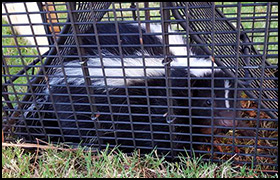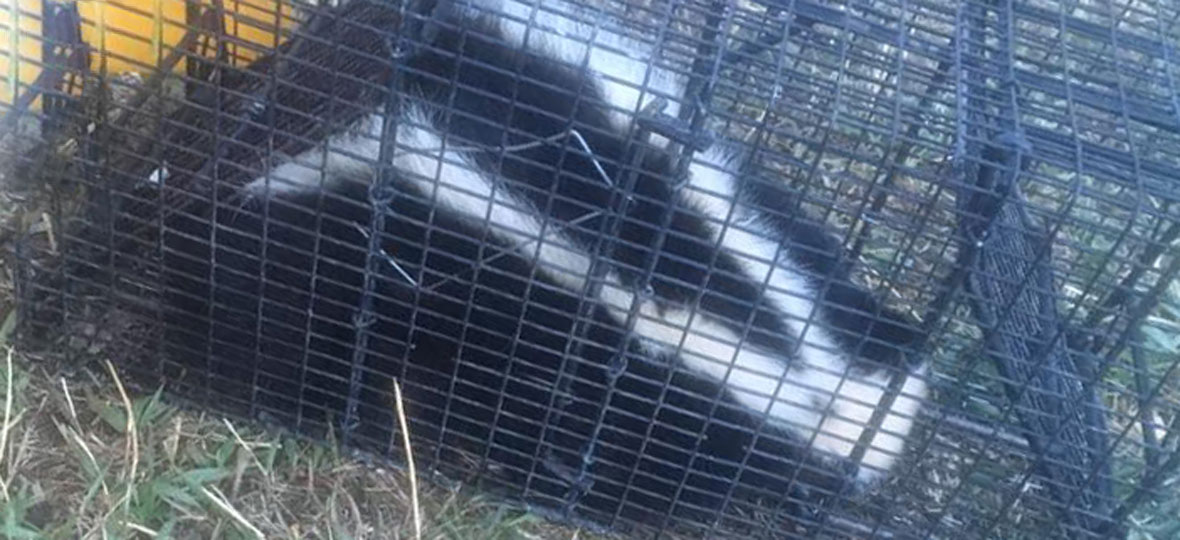Skunk Trapping: How To catch a Skunk

AVOID DIY SKUNK TRAPPING: We DO NOT advise the inexperienced homeowner to attempt skunk trapping. Trapping is rarely the answer to solving a skunk problem, and most amateur wildlife trapping attempts go awry and cause stress or even death for wildlife, skunks and otherwise. You may only worry about the risk of being sprayed, but incorrect trapping can lead to the very common problems of injury or death by heat stroke for the animal, along with non-target catches of unintended animals such as stray cats, opossums, and raccoons. Skunk relocation is often unsuccessful for the uninformed as well - animals face a high mortality rate, and cause competition and stress for established animals. Please attempt prevention techniques first, and call a reputable professional if you absolutely require trapping and removal of the animals.

You should trap a live skunk and then release the skunk in a remote area far away to keep it from returning to your property and causing you further frustration. You can use fully-enclosed traps as an effective method. Plastic box traps are superior compared to the wire traps since they are enclosed completely, reducing the chances of getting sprayed when removing a skunk away from the property. It is good to use over ripe bananas, peanut butter or marshmallows as bait instead of cat food or meat in order to avoid capturing the cats of the neighbors.
People who are tired of dealing with the foul odor from the skunk can crack this problem through using a spray-proof trap. This option will also protect the person from bites and scratches that can accompany a spray. The trap lets the person dispose of the animal in a humane and safe way.
The plastic catch trap is also effective when it comes to catching and transporting the skunks without the risk of being sprayed. The trap is easy to use and it comes with the detailed instructions on how to use it. It is the ideal choice when it comes to trapping the skunk since it is closed completely.
When you want to set up a trap, you have to set it where on earth you have seen the skunk the most. These places are typically porches, sheds and decks. You may set up the trap on the border of your porch or put in an prohibiting barrier. When you have seen the skunk digging holes or harassing your pets, adjust the trap anywhere the animal is capable of smelling the bait. You should look for the place where the skunks like to be or the place where the skunks have caused damage. The skunk can be found in many places, including burrows, porches, hollow logs, brush piles and tree hollows. A trap has to be placed on a level and even surface to make sure that it is stable. You should set up the trap in the evening since the skunks do everything at night. When you find that the cage did not catch something during the night, you need to close it during the day so that you will not catch unwanted critters. Then set it once again during the evenings. After catching the skunk, you have to avoid it spraying on you. To do this, you need to have a bed sheet, blanket or old towel to cover the trap.
The skunks are usually not that hard to trap, but if you have a particularly challenging animal, you can call in the professionals to help you rid your home and property of these nuisance animals. They have the experience, knowledge and equipment to quickly capture the skunks and properly remove them. They can also give you advice on how to keep skunks from coming back on your property.
Read more advice:
Go back to the Skunk Removal home page or email us for more info about Skunk Trapping: How To catch a Skunk

